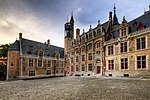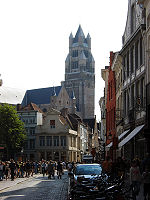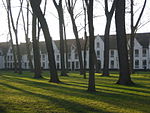Old St. John's Hospital

The Hospital of St. John (Oud Sint-Janshospitaal) was a medieval hospital in Bruges. It was founded in the mid-12th century. Located next to the Church of Our Lady, the premises contain some of Europe's oldest surviving hospital buildings. The hospital grew during the Middle Ages and was a place where sick pilgrims and travellers were cared for. The site was later expanded with the building of a monastery and convent. In the 19th century, further construction led to a hospital with eight wards around a central building. Not until 1977 did the building's function as a hospital stop, at which time it was moved to a newer modern hospital in Brugge Sint-Pieters. The city of Bruges took over the buildings. Today part of the hospital complex holds the popular Hans Memling museum, named for the German-born Early Netherlandish painter, where a number of works, such as triptychs are displayed, as well as hospital records, medical instruments and other works of art.The hospital site is also used as a congress and exhibition centre, the site Oud Sint-Jan.
Excerpt from the Wikipedia article Old St. John's Hospital (License: CC BY-SA 3.0, Authors, Images).Old St. John's Hospital
Mariastraat, Bruges Brugge-Centrum (Brugge)
Geographical coordinates (GPS) Address Website Nearby Places Show on map
Geographical coordinates (GPS)
| Latitude | Longitude |
|---|---|
| N 51.204 ° | E 3.224 ° |
Address
Sint-Janshospitaal
Mariastraat 38
8000 Bruges, Brugge-Centrum (Brugge)
West Flanders, Belgium
Open on Google Maps











